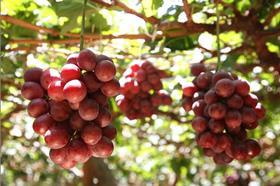
Having secured access to the Korean market a couple of months ago, the Peruvian grape industry received more good news last week when the two countries ratified a Free Trade Agreement (FTA).
The FTA will see Korea’s import duty on Peruvian grapes drop from 45 per cent to 36 per cent with immediate effect, and it will be phased out over the next five years, according to June Choi of Korean fresh fruit importer Sooil Commerce.
The lower duty will give Peruvian grapes a competitive advantage over late-season imports from California, which continue to face a 45 per cent duty year-round. And in the longer term, the duty phase-out should also put Peru on a more level playing field with Chile, which currently enjoys a much lower seasonal tariff for its grapes and kiwifruit under a FTA previously negotiated FTA with Korea.
Between November and April, the tariff on Chilean grapes is currently 12.4 per cent and this is set to drop to 7 per cent next year. According to Hugh Meldrum of Global Fruits, which supplies grapes to the Korean market, that puts Peruvian grapes at a distinct disadvantage to Chilean imports for the time being.
Peru’s grape exports to Asia are heavily dominated by Red Globe, and this will create another challenge in the Korean market, which has been “swinging heavily towards seedless grapes”, according to Mr Meldrum.
Nevertheless, he also sees some good opportunities for Peruvian grapes in Korea, not least given the early timing of their production. “One of the reasons why the volume of Chilean Thompson grapes to Korea has increased so much is that it’s really the only variety available for the first five to six weeks of the season, so if Peru can load Red Globes for arrival before Chile they could have a good opportunity,” he says.
Mr Choi is optimistic that Peruvian grapes can establish a significant presence in the market. “Considering Peru’s shipping season runs from October to February, we think the US and Chile will lose their end-of-season and early-season markets respectively for Red Globe in Korea if Peru’s quality is acceptable,” he told Fruitnet.com.
The US shipped 1,722 tonnes of grapes to Korea between November and January in the 2010 season, up from 808 tonnes in 2009. Chile, meanwhile, sent 3,533 tonnes in January/February 2010, up from 1,896 tonnes in the same months of 2009. The key varieties included Sugraone, Thompson Seedless, Crimson Seedless and Red Globe.
Besides pricing, another key factor in the success of Peruvian grapes is likely to be the eating quality, and there are some question marks here, according to Mr Choi. “I saw Peruvian grapes in the China market this January. The colour and size were good, but the taste was not so good,” he notes. “Also, strong demand `for Red Globe` from Hong Kong/China during this Lunar New Year period will probably limit the volume orders from Korea.”
Mr Meldrum acknowledged the “taste issue” for Peruvian grapes. “This is something the Peruvians will have to overcome – it’s an easy thing to say but it’s not so easy to do,” he noted.
Korea officially opened its doors to Peruvian grapes with effect from 9 May. The quarantine protocol requires fruit to undergo in-transit cold treatment at under 1.1oC for 15 days or under 1.6oC for 17 days. Production must also be sourced from registered orchards and packhouses and pre-cleared by a Korean quarantine inspector.
Import duties on a number of other fresh fruits entering Korea will also be cut under the new FTA between the two countries, including bananas (5 per cent), pineapples (10 per cent), mangoes (10 per cent), grapefruit (10 per cent), cherries (10 per cent), kiwifruit (10 per cent) and durian (10 per cent). Oranges will be subject to a seasonal tariff from 1 May to 31 October, and this will be phased out over the next 10 years from the current level of 45 per cent. Currently, however, the only Peruvian fresh fruits with access to Korea are grapes, bananas and pineapples.



